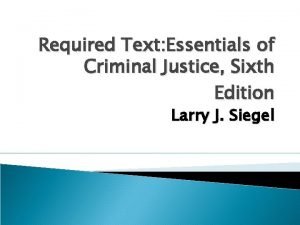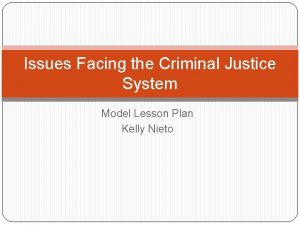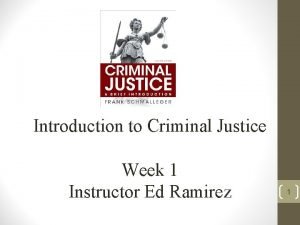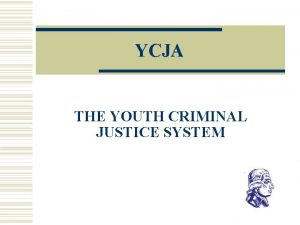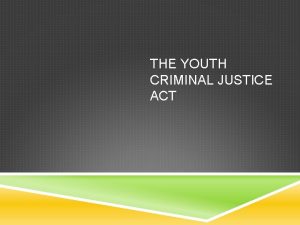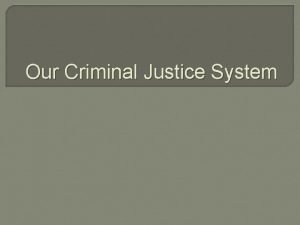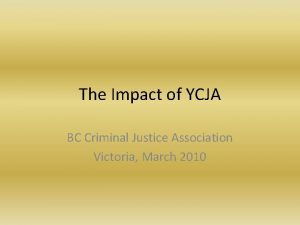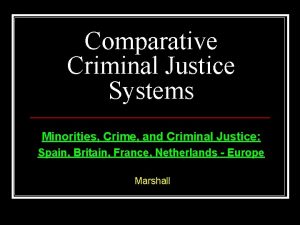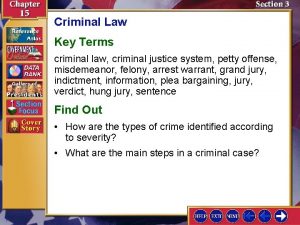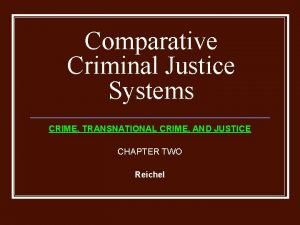Youth and Crime Youth Criminal Justice Act YCJA










- Slides: 10

Youth and Crime: Youth Criminal Justice Act (YCJA – 2003)

History of Youth Justice in Canada Canadian law has commonly seen youth as in need of separate treatment in courts for crimes, when compared to adult offenders As early as Juvenile Delinquency Act (1908), youth were “misdirected, misguided” and in need of “aid, encouragement, help and assistance” Hence priority on rehabilitation as opposed to other objectives of sentencing

History of Youth Justice in Canada Laws regarding criminal activity by ‘minors’ were revised in 1984 with the Young Offenders Act (YOA), which included: criminal proceedings similar to full court trials provided new ways of dealing with ‘at risk’ youth through sentencing that would address the ‘underlying causes of crime’ more safeguards for youth against people in positions of authority that were open to abuse

History of Youth Justice in Canada Reports from Youth Justice Strategy (1998) and Summit on Justice (1999) recommended that YOA be revised for: prevention meaningful consequences for offences by youth harsher punishment for violent repeat offenders Key Recommendations: lowering age of responsibility holding parents more accountable use of incarceration as last resort alternative measures as sentences

Youth Criminal Justice Act Criticism of YOA resulted in creation of the Youth Criminal Justice Act (YCJA 2004) YCJA’s four main principles: prevention by addressing causes of crime and encourage community effort to reduce crime meaningful consequences that hold all young people accountable for their actions (and to help them understand the implications of the harm they’ve done) rehabilitation and reintegration into society flexibility for provinces to establish youth justice policies that best meet their local needs for youth

Who is a ‘Youth’? 0 – 11 years old = ‘child’; no criminal responsibility 12 – 17 = ‘youth’; partial criminal responsibility 18 + = ‘adult’; full criminal responsibility By contrast, the Juvenile Delinquents Act designated 7 + yrs old as partially criminally responsible

Major Changes with YCJA Increased role for rehabilitation programs for non- violent, violent and repeat offenders Introduced stiffer sentences for violent offenders (e. g. – murder, manslaughter & aggravated sexual assault committed by 14 yrs + can have sentences as adults) Hardships for Aboriginal offenders need to be considered when sentencing Equal to ½ of sentenced time in custody must be served in community as period of supervision

Provisions of YCJA The YCJA does not outline any new crimes that would involve only youth YCJA outlines how ‘young offenders’ are to be dealt with when arrested for a crime listed in the Canadian Criminal Code Youth now have same rights as adults as listed in the Charter of Rights and Freedoms Youth have additional rights upon particular types of arrest

Provisions of YCJA Youth are not necessarily arrested when caught breaking the law (incident is recorded by police, however) If crime is non-violent or a first-time offence, youth may become involved in an alternative measures program, avoiding courts altogether Examples of alternative measures programs: Community service Essay/presentation/referral Social skills improvement

Youth Crime Statistics See Stats Canada -> Crime and Justice (Youth): http: //www 40. statcan. gc. ca/l 01/ind 01/l 3_20000_20 002 -eng. htm? hili_none
 Criminal justice and public policy guelph
Criminal justice and public policy guelph The oldest community-based correctional program is
The oldest community-based correctional program is Chapter 11 basic concepts street law
Chapter 11 basic concepts street law Diversion program under ra 9344
Diversion program under ra 9344 Criminal justice wedding cake
Criminal justice wedding cake State of ct division of criminal justice
State of ct division of criminal justice Wedding cake model of criminal justice examples
Wedding cake model of criminal justice examples Grass eater police
Grass eater police Criminal justice lesson
Criminal justice lesson Consensus model criminal justice
Consensus model criminal justice Consensus model criminal justice
Consensus model criminal justice






